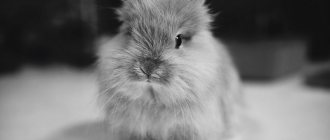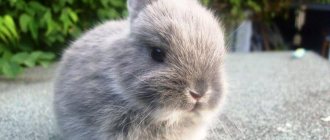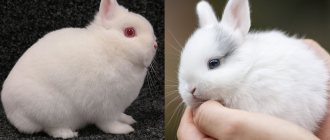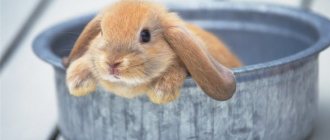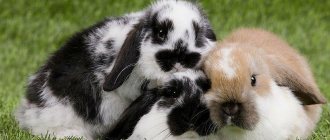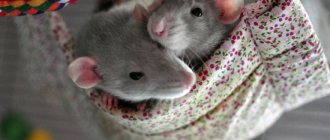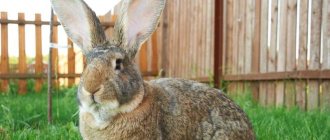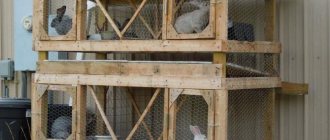Almost any rabbit can be classified as decorative if it is kept in your home. This is often the name given to dwarf breeds of animals weighing from 1.5 to 2.5 kg. The cost of an eared friend varies significantly. It is possible to purchase it both for 700 rubles and at a price of 25 thousand rubles.
Features of the view
Decorative rabbits were bred for indoor use. It is best to buy them in nurseries or from trusted breeders - stores rarely follow the rules for caring for the animal and do not give any guarantees that you will buy a healthy animal.
On sale you can find different types of decorative rabbits - with erect ears, ram rabbits, with red eyes, and so on. The most beautiful breeds are those with long hair, but keep in mind that they require careful care (the fur is combed daily).
Dwarf rabbit breeds are classified by coat length, weight and ear shape.
Ornamental rabbits can also be raised for meat and fur. In this case, fairly large specimens are used.
The life expectancy and health of your pet largely depends on you, or rather on how carefully you comply with the conditions of its maintenance. In general, a decorative rabbit is a breed for the soul; such an animal will become a true friend for the whole family.
Difference between decorative and dwarf rabbit
Buyers often confuse these two concepts. Any pet, regardless of its size, kept in the house can be called decorative. This is a pet.
Dwarf species include fluffies, whose size is small. They can also take the place of a family pet.
Popular breeds
Let's look at the most popular breeds of decorative rabbits for home raising:
- Lop-eared dwarf Ram - he looks spontaneous and funny due to the original shape of his ears, which seem to form a horseshoe.
How long do dwarf rams live and how to care for them?
article.
- Colored dwarfs - available in a wide variety of colors; they are cute and easy-to-care animals.
- Dwarf foxes have long, very pleasant to the touch fur. The fur color can be white, red or blue.
- Dwarf Angoras have luxurious fur and are especially popular with young children.
Angora dwarf rabbit
- Rex - wide range of colors, plush fur, very pleasant to the touch. An ideal breed for small children.
- Japanese dwarf - can be two-colored.
- Hermelines are white dwarf rodents with red or blue eyes. The fur is short and thick.
Dwarf rabbit Hermelin
Before choosing, be sure to carefully read the characteristics of the breed and consult with the breeder. The fact is that each type of decorative rabbit has its own character, the features of which are best known in advance.
Some breeds like Hermelins are quite aggressive, so they are not worth buying for children.
Content
Caring for decorative rabbits is quite simple. The animals are clean, do not require much space, tolerate transportation well and do not need daily walks. For high-quality maintenance of a decorative rabbit you need:
- spacious cage - at least 4 times larger than the animal itself;
- plastic tray - the animal’s paws fall through the lattice;
- automatic drinking bowl, feed bowl , manger (hay is stored in them).
The place to install the cage must be warm. The house is cleaned at least twice a month, the tray is washed weekly. You can carry out hygiene procedures more often if you wish.
A rabbit cage should be 4 times larger than the animal itself.
Decorative rabbits do not tolerate bright sunlight and drafts. Take this into account when choosing a location to install the cage.
Keep in mind that animals love to chew on everything, so keep an eye on them when you release them into the wild - otherwise wires, plants, and shoes will be damaged. You can give your rabbits toys - they will be distracted and stop spoiling everything around them. They especially like planks, cardboard, paper boxes, and pieces of fabric. There is usually no need to bathe the animal - rabbits lick their own fur. If you do get it wet, dry it without drafts—the animals catch colds and get sick quickly.
You need to be careful when handling baby rabbits, as their bones are very fragile. Also, decorative breeds are very shy, so proximity to cats and dogs is contraindicated for them (yes, there are exceptions, but it’s better not to risk it).
Under no circumstances should animals be dropped on the floor - such a flight may be the last in their life.
Care
On average, decorative rabbits live 7-8 years; long-livers are not found among them. To make the animal comfortable:
- release him from the cage;
- talk, pick up, stroke;
- Disturb the rabbit as little as possible during the day;
- Make sure there is enough clean water and a variety of food in the cage;
- get vaccinated on time (read more about vaccination of rabbits here);
- trim your claws.
Be sure to give your pet a name, preferably taking into account its character and individual characteristics. You can use the names of cartoon characters or human ones. If you bought an animal for your baby, choose a nickname together.
Domestic rabbits are social animals. They need communication and attention. This affects their lifespan.
You need to communicate with rabbits - this way they feel better and live longer.
Treats for decorative rabbits (list)
Suitable succulent food for rabbits:
- cabbage;
- carrot;
- Bulgarian pepper;
- beet;
- tomatoes;
- potato;
- other vegetables.
“Vegetable” lunch is served in the morning and at noon. It is advisable to alternate products. You should not feed cabbage frequently to avoid causing excessive gas or bloating.
The greens are slightly dried before serving. You can combine it with vegetables. Lettuce, parsley, celery are suitable for rabbits.
Need to know! Fruits, like berries, are considered a delicacy, so you shouldn’t pamper your fluffy with them often. Preference is given to apples, pears, and grapes.
Diseases
Decorative rabbits can suffer from infectious and viral diseases. The main ones are rhinitis, stomatitis, staphylococcosis, otitis, conjunctivitis. The animals suffer from intestinal disorders, and the active growth of teeth causes them severe inconvenience. A complete list of diseases of decorative rabbits is presented in this material.
It is recommended that decorative rabbits receive vaccinations - and, believe me, they will cost you much less than further treatment.
Competent care and proper feeding will help to avoid diseases. Make sure that the animal’s diet is balanced, otherwise constant diarrhea cannot be avoided.
Stomach upset is caused by weevil-infected dry food, excess fruits and vegetables, moldy bread, sudden changes in feed, gastrointestinal diseases, unsanitary conditions, and viruses. A common occurrence is constipation. Read what to do if your rabbit is constipated here.
In case of diarrhea, you need to disinfect the cage and give the animal a decoction of chamomile. If it doesn't go away for a long time, contact your veterinarian.
It is necessary to monitor the health of rabbits by regularly conducting veterinary examinations.
Feeding methods at home
There are classic feeding options or natural and artificial, using concentrated additives and feed.
The classic may not be suitable for everyone, as it is a troublesome option. The animal is fed:
- harvested grass;
- hay;
- greens;
- tree branches;
- leaves;
- mineral or salt stones.
For information! The rabbit needs to grind down its teeth, so bark is ideal for such purposes.
The second approach involves the use of mixed feed. By including concentrated supplements and feed in your animal’s diet, you don’t have to store hay for the winter.
This option greatly facilitates care and maintenance, but it is worth remembering about the health of your pet. It is unknown how such nutrition will affect the fragile body of a dwarf animal. Is it worth the risk?
Features of breeding for sale
Decorative rabbits give birth approximately 8 times a year, but this number may be less. Small breeds begin to reproduce at approximately 6-7 months.
The behavior of a female rabbit that is ready to breed changes dramatically - she rakes the litter into one place and begins to build a nest. For mating, the female is placed next to the rabbit (strictly - the opposite cannot be done).
It is recommended to leave her in the male’s cage for some more time for repeated matings, and then return her back to her house.
After giving birth, the baby rabbits are left with their mother
If the female is not ready to mate, she will thump her hind legs and simply behave aggressively. In this case, the animals are seated and wait for a more favorable moment.
After mating, a pregnant female, after a couple of weeks, when she joins the male, begins to behave unkindly and fights off. This is how they determine whether it is covered or not. The method is not 100%, since some pregnant females also like to mate.
You can carefully palpate the rabbit's body - small rabbits feel like balls. Under no circumstances put pressure on your stomach, especially not too much. Also, pregnant females often develop a voracious appetite. Birth occurs on average 31 days after covering. The baby rabbits are left in the cage with the mother - she feeds and licks them.
